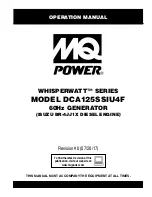
DCA125SSIU4F 60 HZ GENERATOR• OPERATION MANUAL — REV. #0 (07/20/17) — PAGE 15
INSTALLATION
OUTDOOR INSTALLATION
Install the generator in a area that is free of debris,
bystanders, and overhead obstructions. Make sure the
generator is on secure level ground so that it cannot slide
or shift around. Also install the generator in a manner so
that the exhaust will not be discharged in the direction of
nearby homes.
The installation site must be relatively free from moisture
and dust. All electrical equipment should be protected from
excessive moisture. Failure to do will result in deterioration
of the insulation and will result in short circuits and
grounding.
Foreign materials such as dust, sand, lint and abrasive
materials have a tendency to cause excessive wear to
engine and alternator parts.
INDOOR INSTALLATION
Exhaust gases from diesel engines are extremely
poisonous. Whenever an engine is installed indoors the
exhaust fumes must be vented to the outside. The engine
should be installed at least two feet from any outside wall.
Using an exhaust pipe which is too long or too small can
cause excessive back pressure which will cause the engine
to heat excessively and possibly burn the valves.
MOUNTING
The generator must be mounted on a solid foundation
(such as concrete) and set firmly on the foundation to
isolate vibration of the generator when it is running. The
generator must set at least 6 inches above the floor or grade
level (in accordance to NFPA 110, Chapter 54.1).
DO NOT
remove the metal skids on the bottom of the generator.
They are to resist damage to the bottom of the generator
and to maintain alignment.
CAUTION
Pay close attention to ventilation when operating the
generator inside tunnels and caves. The engine exhaust
contains noxious elements. Engine exhaust must be
routed to a ventilated area.
GENERATOR GROUNDING
if applicable ,to guard against electrical shock and possible
damage to the equipment, it is important to provide a good
EARTH
ground, (Figure 2).
Article 250 (Grounding) of the NEC handbook provides
guidelines for proper grounding and specifies that the cable
ground shall be connected to the grounding system of the
building as close to the point of cable entry as practical.
NEC article 250 specifices the following grounding
requirements:
1. Use one of the following wire types to connect the
generator to earth ground.
a. Copper 10 AWG (5.3 mm
2
) or larger.
b. Aluminum 8 AWG (8.4 mm
2
) or larger.
2. When grounding of the generator (Figure 2) is required,
connect one end the ground cable to the ground lug
on the generator. Connect the other end of the ground
cable to the ground rod (earth ground).
3. NEC article 250 specifies that the earth ground rod
should be buried a minimum of 8 ft. into the ground.
NOTICE
The Occupational Safety and Health Administration
(OSHA) and the National Electrical Code (NEC)
recommend that if the generator is providing electrical
power to a structure (home, office shop, trailer or
similar) it
must
be connected to a grounding electrode
system, such a driven ground rod (Figure 2).
NOTICE
ALWAYS
check with State, Province, District and
Municipalities for electrical grounding requirements
before using generator.
NOTICE
When connecting the generator to any buildings
electrical system
ALWAYS
consult with a licensed
electrician.
















































